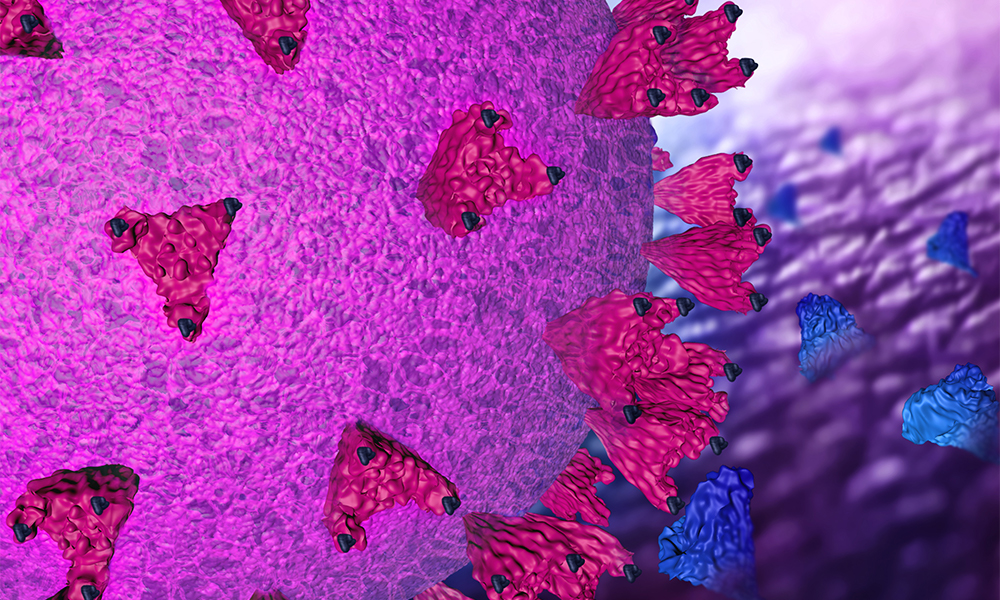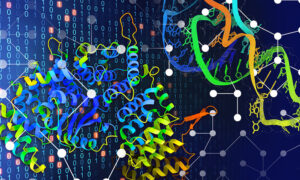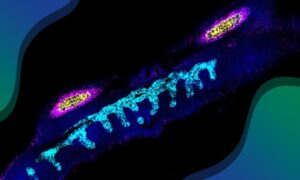Scientists identify synthetic mini-antibody to combat COVID-19
By screening hundreds of synthetic mini-antibodies called sybodies, a group of scientists has identified one that might stop SARS-CoV-2 from infecting human cells

Llama’s mini-antibodies and their synthetic imitations
The ability of SARS-CoV-2 to infect cells depends on interactions between the viral spike protein and the human cell surface protein ACE2. To enable the virus to hook onto the cell surface, the spike protein binds ACE2 using three finger-like protrusions, called the receptor binding domains (RBDs). Blocking the RBDs therefore has the potential to stop the virus from entering human cells. This can be done using antibodies.
Nanobodies, small antibodies found in camels and llamas, are promising as tools against viruses due to their high stability and small size. Although obtaining them from animals is time consuming, technological advances now allow for rapid selection of synthetic nanobodies, called sybodies. A technology platform to select sybodies from large synthetic libraries was recently developed in the lab of Markus Seeger at the University of Zurich, and made available for this study.
In search of the best sybody against SARS-CoV-2
EMBL Hamburg’s Christian Löw group searched through the existing libraries to find sybodies that could block SARS-CoV-2 from infecting human cells. First, they used the viral spike protein’s RBDs as bait to select those sybodies that bind to them. Next, they tested the selected sybodies according to their stability, effectiveness, and the precision of binding. Among the best binders, one called sybody 23 turned out to be particularly effective in blocking the RBDs.
To learn exactly how sybody 23 interacts with the viral RBDs, researchers in the group of Dmitri Svergun at EMBL Hamburg analysed the binding of sybody 23 to the RBDs by small-angle X-ray scattering. In addition, Martin Hällberg at CSSB and Karolinska Institutet used cryo-EM to determine the structure of the full SARS-CoV-2 spike bound to sybody 23. The RBDs switch between two positions: in the ‘up’ position the RBDs poke out, ready to bind ACE2; in the ‘down’ position they are furled to hide from the human immune system. The molecular structures revealed that sybody 23 binds RBDs in both ‘up’ and ‘down’ positions, and blocks the areas where ACE2 would normally bind. This ability to block RBDs regardless of their position might explain why sybody 23 is so effective.
Finally, to test if sybody 23 can neutralise a virus, the group of Ben Murrell at Karolinska Institutet used a different virus, called a lentivirus, modified such that it carried SARS-CoV-2’s spike protein on its surface. They observed that sybody 23 successfully disabled the modified virus in vitro. Additional tests will be necessary to confirm whether this sybody could stop SARS-CoV-2 infection in the human body.
Scientific collaboration during lockdown
“The collaborative spirit has been enormous in these times, and everybody was motivated to contribute,” says Christian Löw, one of the lead scientists in the study. The researchers started the project as soon as they received approval from EMBL leadership to reopen their laboratories during the COVID-19 lockdown. They managed to select the candidate sybodies and perform the analyses in just a few weeks.
“Getting the results so quickly was only possible because the methodologies we used had already been established for other research projects unrelated to SARS-CoV-2. Developing these tools would have taken significantly more time and resources,” says Löw.
The results of this project hold out the promise of a potential way to treat COVID-19. In future work, the scientists will perform further analyses to confirm whether sybody 23 could be an effective COVID-19 treatment.
Wissenschaftler identifizieren synthetische Mini-Antikörper zur Bekämpfung von COVID-19
Durch ein Screening von hunderten synthetischen Mini-Antikörpern, sogenannten Sybodies, identifizierten Wissenschaftlern einen solchen Mini-Antikörper, der SARS-CoV-2 daran hindern könnte, menschliche Zellen zu infizieren

Lama-Mini-Antikörper und ihre synthetischen Imitationen
Die Fähigkeit von SARS-CoV-2, Zellen zu infizieren, hängt von den Wechselwirkungen zwischen dem viralen Spike-Protein und dem menschlichen Zelloberflächenprotein ACE2 ab. Damit sich das Virus an der Zelloberfläche festhaken kann, bindet das Spike-Protein ACE2 über drei fingerartige Vorsprünge, die so genannten Rezeptorbindungsdomänen (RBDs). Die Blockierung der RBDs hat daher das Potenzial, das Eindringen des Virus in menschliche Zellen zu verhindern. Dies kann mit Hilfe von Antikörpern erreicht werden.
Nanokörper, kleine Antikörper, die in Kamelen und Lamas gefunden werden, sind aufgrund ihrer hohen Stabilität und ihrer geringen Größe vielversprechende Werkzeuge gegen Viren. Obwohl ihre Gewinnung aus Tieren zeitaufwändig ist, erlauben technologische Fortschritte heute eine schnelle Auswahl synthetischer Nanokörper, so genannter Sybodies. Eine Technologieplattform zur Auswahl von Sybodies aus großen synthetischen Datenbanken wurde kürzlich im Labor von Markus Seeger an der Universität Zürich entwickelt und für diese Studie zur Verfügung gestellt.
Auf der Suche nach den besten Leuten gegen SARS-CoV-2
Die Gruppe von Christian-Löw am EMBL Hamburg durchsuchte die vorhandenen Datenbanken nach Sybodies, die SARS-CoV-2 daran hindern könnten, menschliche Zellen zu infizieren. Zunächst benutzten sie die RBDs des viralen Spike-Proteins als Köder, um diejenigen Sybodies auszuwählen, die sich an sie binden. Als nächstes testeten sie die ausgewählten Sybodies auf ihre Stabilität, Wirksamkeit und die Präzision der Bindung. Unter den besten Bindemitteln erwies sich eines, das Sybody 23 genannt wurde, als besonders wirksam bei der Blockierung der RBDs.
Um genau zu erfahren, wie Sybody 23 mit den viralen RBDs interagiert, analysierten Forscher in der Gruppe von Dmitri Svergun, ebenfalls am EMBL Hamburg, die Bindung von Sybody 23 an die RBDs durch Röntgenkleinwinkelstreuung. Darüber hinaus verwendete Martin Hällberg am CSSB und Karolinska Institutet Kryo-EM, um die Struktur des vollständigen SARS-CoV-2-Spike zu bestimmen, der an Sybody 23 gebunden ist. Die RBDs wechseln zwischen zwei Positionen: In der “oberen” Position zeigen die RBDs nach außen und sind bereit, ACE2 zu binden; in der “unteren” Position sind sie zusammengerollt, um sich vor dem menschlichen Immunsystem zu verstecken. Die molekularen Strukturen zeigten, dass alle 23 RBDs sowohl in der “oberen” als auch in der “unteren” Position binden und die Bereiche blockieren, in denen ACE2 normalerweise binden würde. Diese Fähigkeit, RBDs unabhängig von ihrer Position zu blockieren, könnte erklären, warum Sybody 23 so wirksam ist.
Um schließlich zu testen, ob Sybody 23 ein Virus neutralisieren kann, verwendete die Gruppe von Ben Murrell vom Karolinska Institutet das so genannte Lentivirus, das so modifiziert wurde, dass es das Spike-Protein von SARS-CoV-2 auf seiner Oberfläche trägt. Sie beobachteten, Sybody 23 das modifizierte Virus in vitro erfolgreich deaktivierte. Weitere Tests werden notwendig sein, um zu bestätigen, ob das Sybody die Infektion von SARS-CoV-2 im menschlichen Körper stoppen kann.
Wissenschaftliche Zusammenarbeit während einer Pandemie
„Der Teamgeist in diesen Zeiten ist enorm, und jeder war motiviert, seinen Beitrag zu leisten,“ sagt Christian Löw, einer der leitenden Wissenschaftler der Studie. Die Forscher begannen das Projekt, sobald sie von der Leitung des EMBL die Genehmigung erhielten, ihre Labors während des COVID-19-Lockdowns wieder zu öffnen. Es gelang ihnen, in nur wenigen Wochen die Synbodies auszuwählen und die Analysen durchzuführen.
„Die Ergebnisse so schnell zu erhalten war nur möglich, weil die von uns verwendeten Methoden bereits für andere Forschungsprojekte, die nichts mit SARS-CoV-2 zu tun hatten, festgelegt worden waren. Die Entwicklung dieser Methoden hätte deutlich mehr Zeit und Ressourcen in Anspruch genommen,“ sagt Löw.
Die Ergebnisse dieses Projekts versprechen einen möglichen Weg zur Behandlung von COVID-19. In zukünftigen Arbeiten werden die Wissenschaftler weitere Analysen durchführen, um zu bestätigen, ob Sybody 23 eine wirksame COVID-19-Behandlung sein könnte.



